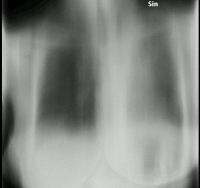
Photo from wikipedia
BACKGROUND In the last decade, endoscopic skull base surgery has significantly developed and generated a plethora of techniques and approaches for access to the cranial ventral floor. However, the exploration… Click to show full abstract
BACKGROUND In the last decade, endoscopic skull base surgery has significantly developed and generated a plethora of techniques and approaches for access to the cranial ventral floor. However, the exploration for the least-aggressive, maximally efficient approach continues. OBJECTIVE To describe in detail an anatomical study, along with the technical nuances of a novel endoscopic approach to Meckel's Cave (MC) using a lateral transorbital (LTO) route. METHODS Eighteen orbits of injected cadaveric specimens were operated on, using an endoscopic LTO approach to MC, middle cranial fossa, and paramedian skull base preserving the orbital rim. Surgical navigation and an after-the-fact infratemporal craniectomy were utilized to identify the limits of the approach. RESULTS Following a transorbital approach opening a trapezoid window at the superolateral aspect (average 166.7 mm 2 ), a middle fossa "peeling" and full visualization of MC was accomplished with no difficulties in all specimens. The entire approach was performed extradurally without the need to expose the temporal lobe. CONCLUSION In a cadaveric model, the endoscopic LTO approach affords a direct route to access MC. Its main advantage is that it is minimally disruptive in nature, less brain retraction is required, and it reaches the middle fossa in an anterolateral perspective. It also requires no manipulation of the temporalis muscle, limited cosmetic incision, and rapid recovery. It seems a viable alternative to traditional approaches for lesions lateral to the cranial nerves at the cavernous sinus and MC, that is, schwannomas. Clinical utilization of this approach will challenge its efficacy and identify limitations.
Journal Title: Operative neurosurgery
Year Published: 2017
Link to full text (if available)
Share on Social Media: Sign Up to like & get
recommendations!